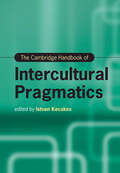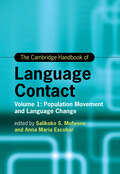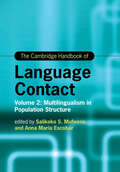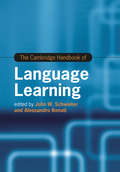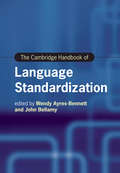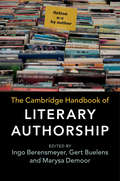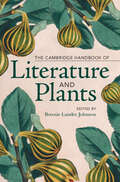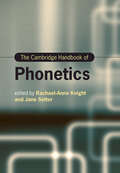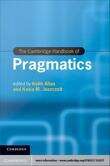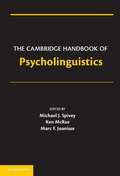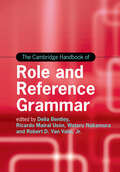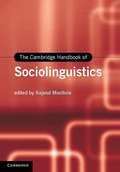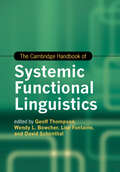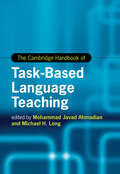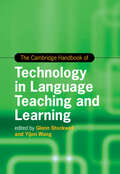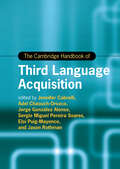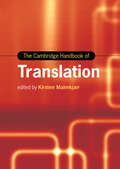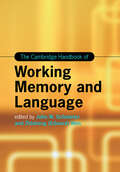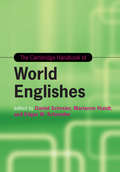- Table View
- List View
The Cambridge Handbook of Intercultural Pragmatics (Cambridge Handbooks in Language and Linguistics)
by Istvan KecskesIntercultural pragmatics addresses one of the major issues of human communication in the globalized world: how do people interact with each other in a language other than their native tongue, and with native speakers of the language of interaction? Bringing together a globally-representative team of scholars, this Handbook provides an authoritative overview to this fascinating field of study, as well as a theoretical framework. Chapters are grouped into 5 thematic areas: theoretical foundation, key issues in Intercultural Pragmatics research, the interface between Intercultural Pragmatics and related disciplines, Intercultural Pragmatics in different types of communication, and language learning. It addresses key concepts and research issues in Intercultural Pragmatics, and will trigger fresh lines of enquiry and generate new research questions. Comprehensive in its scope, it is essential reading not only for scholars of pragmatics, but also of discourse analysis, cognitive linguistics, communication, sociolinguistics, linguistic anthropology, and second language teaching and learning.
The Cambridge Handbook of Language Contact: Volume 1: Population Movement and Language Change (Cambridge Handbooks in Language and Linguistics)
by Anna María Escobar Salikoko S. MufweneLanguage contact - the linguistic and social outcomes of two or more languages coming into contact with each other - has been pervasive in human history. However, where histories of language contact are comparable, experiences of migrant populations have been only similar, not identical. Given this, how does language contact work? With contributions from an international team of scholars, this Handbook - the first in a two-volume set - delves into this question from multiple perspectives and provides state-of-the-art research on population movement and language contact and change. It begins with an overview of how language contact as a research area has evolved since the late 19th century. The chapters then cover various processes and theoretical issues associated with population movement and language contact worldwide. It is essential reading for anybody interested in the dynamics of social interactions in diverse contact settings and how the changing ecologies influence the linguistic outcomes.
The Cambridge Handbook of Language Contact: Volume 2: Multilingualism in Population Structure (Cambridge Handbooks in Language and Linguistics)
by Anna María Escobar Salikoko S. MufweneLanguage contact - the linguistic and social outcomes of two or more languages coming into contact with each other - starts with the emergence of multilingual populations. Multilingualism involving plurilingualism can have various consequences beyond borrowing, interference, and code-mixing and -switching, including the emergence of lingua francas and new language varieties, as well as language endangerment and loss. Bringing together contributions from an international team of scholars, this Handbook - the second in a two-volume set - engages the reader with the manifold aspects of multilingualism and provides state-of-the-art research on the impact of population structure on language contact. It begins with an introduction that presents the history of the scholarship on the subject matter. The chapters then cover various processes and theoretical issues associated with multilingualism embedded in specific population structures worldwide as well as their outcomes. It is essential reading for anybody interested in how people behave linguistically in multilingual or multilectal settings.
The Cambridge Handbook of Language Learning (Cambridge Handbooks in Language and Linguistics)
by John W. Schwieter Alessandro BenatiProviding a comprehensive survey of cutting-edge work on second language learning, this Handbook, written by a team of leading experts, surveys the nature of second language learning and its implications for teaching. Prominent theories and methods from linguistics, psycholinguistics, processing-based, and cognitive approaches are covered and organised thematically across sections dealing with skill development, individual differences, pedagogical interventions and approaches, and context and environment. This state-of-the-art volume will interest researchers in second language studies and language education, and will also reach out to advanced undergraduate and graduate students in these and other related areas.
The Cambridge Handbook of Language Standardization (Cambridge Handbooks in Language and Linguistics)
by Wendy Ayres-Bennett John BellamyLanguage standardization is the process by which conventional forms of a language are established and maintained. Bringing together internationally renowned experts, this Handbook provides a comprehensive overview of standardization, norms and standard languages. Chapters are grouped into five thematic areas: models and theories of standardization, questions of authority and legitimacy, literacy and education, borders and boundaries, and standardization in Late Modernity. Each chapter addresses a specific issue in detail, illustrating it with linguistic case studies and taking into account the particular political, social and cultural context. Showcasing cutting-edge research, it offers fresh perspectives that go beyond traditional accounts of the standardization of national European languages, and affords new insights into minoritized, indigenous and stateless languages. Surveying a wide range of languages and approaches, this Handbook is an essential resource for all those interested in language standards and standard languages.
The Cambridge Handbook of Linguistic Anthropology
by Jack Sidnell N. J. Enfield Paul Kockelman N. J. Enfield Paul KockelmanThe field of linguistic anthropology looks at human uniqueness and diversity through the lens of language, our species' special combination of art and instinct. Human language both shapes, and is shaped by, our minds, societies, and cultural worlds. This state-of-the-field survey covers a wide range of topics, approaches and theories, such as the nature and function of language systems, the relationship between language and social interaction, and the place of language in the social life of communities. Promoting a broad vision of the subject, spanning a range of disciplines from linguistics to biology, from psychology to sociology and philosophy, this authoritative handbook is an essential reference guide for students and researchers working on language and culture across the social sciences.
The Cambridge Handbook of Linguistic Typology (Cambridge Handbooks in Language and Linguistics)
by Alexandra Y. Aikhenvald R. M. W. DixonLinguistic typology identifies both how languages vary and what they all have in common. This Handbook provides a state-of-the art survey of the aims and methods of linguistic typology, and the conclusions we can draw from them. Part I covers phonological typology, morphological typology, sociolinguistic typology and the relationships between typology, historical linguistics and grammaticalization. It also addresses typological features of mixed languages, creole languages, sign languages and secret languages. Part II features contributions on the typology of morphological processes, noun categorization devices, negation, frustrative modality, logophoricity, switch reference and motion events. Finally, Part III focuses on typological profiles of the mainland South Asia area, Australia, Quechuan and Aymaran, Eskimo-Aleut, Iroquoian, the Kampa subgroup of Arawak, Omotic, Semitic, Dravidian, the Oceanic subgroup of Austronesian and the Awuyu-Ndumut family (in West Papua). Uniting the expertise of a stellar selection of scholars, this Handbook highlights linguistic typology as a major discipline within the field of linguistics.
The Cambridge Handbook of Literary Authorship
by Ingo Berensmeyer Gert Buelens Marysa DemoorThis Handbook surveys the state of the art in literary authorship studies. Its 27 original contributions by eminent scholars offer a multi-layered account of authorship as a defining element of literature and culture. Covering a vast chronological range, Part I considers the history of authorship from cuneiform writing to contemporary digital publishing; it discusses authorship in ancient Egypt, Greece, Rome, early Jewish cultures, medieval, Renaissance, modern, postmodern and Chinese literature. The second part focuses on the place of authorship in literary theory, and on challenges to theorizing literary authorship, such as gender and sexuality, postcolonial and indigenous contexts for writing. Finally, Part III investigates practical perspectives on the topic, with a focus on attribution, anonymity and pseudonymity, plagiarism and forgery, copyright and literary property, censorship, publishing and marketing and institutional contexts.
The Cambridge Handbook of Literature and Plants
by Bonnie Lander JohnsonThe first of its kind, this wide-ranging, accessible handbook covers literary engagement with plants in over two thousand years of writing from around the world. It includes within its broad ambit historical periods of Latin, Norse and Anglophone plant literatures, prominent plant genres, and the literatures of major global regions. Chapters explore the history of literary thinking about plants as creatures that do or do not resemble us; our use of plants to negotiate geo-political conflict; the ethical dimension of plant sensibilities; the moral dimension of our desire to engage aesthetically with plants; the ways in which human-plant relations have been used to make and unmake national and ethnic identities; the role of plant-writing in the development of literary form; and the ways we have used plants to navigate modernity's cultural and intellectual shift from theological engagement with the created world to the discourses of modern science.
The Cambridge Handbook of Metaphor and Thought
by Raymond W. Gibbs Jr.The Cambridge Handbook of Metaphor and Thought offers the most comprehensive collection of essays in multidisciplinary metaphor scholarship that has ever been published. These essays explore the significance of metaphor in language, thought, culture, and artistic expression. There are five main themes of the book: the roots of metaphor, metaphor understanding, metaphor in language and culture, metaphor in reasoning and feeling, and metaphor in nonverbal expression. Contributors come from a variety of academic disciplines, including psychology, linguistics, philosophy, cognitive science, literature, education, music, and law.
The Cambridge Handbook of Phonetics (Cambridge Handbooks in Language and Linguistics)
by Rachael-Anne Knight Jane SetterPhonetics - the study and classification of speech sounds - is a major sub-discipline of linguistics. Bringing together a team of internationally renowned phoneticians, this handbook provides comprehensive coverage of the most recent, cutting-edge work in the field, and focuses on the most widely-debated contemporary issues. Chapters are divided into five thematic areas: segmental production, prosodic production, measuring speech, audition and perception, and applications of phonetics. Each chapter presents an historical overview of the area, along with critical issues, current research and advice on the best practice for teaching phonetics to undergraduates. It brings together global perspectives, and includes examples from a wide range of languages, allowing readers to extend their knowledge beyond English. By providing both state-of-the-art research information, and an appreciation of how it can be shared with students, this handbook is essential both for academic phoneticians, and anyone with an interest in this exciting, rapidly developing field.
The Cambridge Handbook of Pragmatics
by Kasia M. Jaszczolt Keith AllanPragmatics is the study of human communication: the choices speakers make to express their intended meaning and the kinds of inferences that hearers draw from an utterance in the context of its use. This Handbook surveys pragmatics from different perspectives, presenting the main theories in pragmatic research, incorporating seminal research as well as cutting-edge solutions. It addresses questions of rational and empirical research methods, what counts as an adequate and successful pragmatic theory, and how to go about answering problems raised in pragmatic theory. In the fast-developing field of pragmatics, this Handbook fills the gap in the market for a one-stop resource to the wide scope of today's research and the intricacy of the many theoretical debates. It is an authoritative guide for graduate students and researchers with its focus on the areas and theories that will mark progress in pragmatic research in the future.
The Cambridge Handbook of Psycholinguistics
by Michael J. Spivey Ken Mcrae Marc F. JoanisseOur ability to speak, write, understand speech, and read is critical to our ability to function in today's society. As such, psycholinguistics, or the study of how humans learn and use language, is a central topic in cognitive science. This comprehensive handbook is a collection of chapters written not by practitioners in the field, who can summarize the work going on around them, but by trailblazers from a wide array of subfields, who have been shaping the field of psycholinguistics over the last decade. Some topics discussed include how children learn language, how average adults understand and produce language, how language is represented in the brain, how brain-damaged individuals perform in terms of their language abilities, and computer-based models of language and meaning. This is required reading for advanced researchers, graduate students, and upper-level undergraduates who are interested in the recent developments and the future of psycholinguistics.
The Cambridge Handbook of Role and Reference Grammar (Cambridge Handbooks in Language and Linguistics)
by Delia Bentley Ricardo Mairal Usón Wataru Nakamura Robert D. Van Valin Jr.Role and Reference Grammar (RRG) is a theory of language in which linguistic structures are accounted for in terms of the interplay of discourse, semantics and syntax. With contributions from a team of leading scholars, this Handbook provides a field-defining overview of RRG. Assuming no prior knowledge, it introduces the framework step-by-step, and includes a pedagogical guide for instructors. It features in-depth discussions of syntax, morphology, and lexical semantics, including treatments of lexical and grammatical categories, the syntax of simple clauses and complex sentences, and how the linking of syntax with semantics and discourse works in each of these domains. It illustrates RRG's contribution to the study of language acquisition, language change and processing, computational linguistics, and neurolinguistics, and also contains five grammatical sketches which show how RRG analyses work in practice. Comprehensive yet accessible, it is essential reading for anyone who is interested in how grammar interfaces with meaning.
The Cambridge Handbook of Second Language Acquisition
by Julia Herschensohn Martha Young-ScholtenWhat is language and how can we investigate its acquisition by children or adults? What perspectives exist from which to view acquisition? What internal constraints and external factors shape acquisition? What are the properties of interlanguage systems? This comprehensive 31-chapter handbook is an authoritative survey of second language acquisition (SLA). Its multi-perspective synopsis on recent developments in SLA research provides significant contributions by established experts and widely recognized younger talent. It covers cutting edge and emerging areas of enquiry not treated elsewhere in a single handbook, including third language acquisition, electronic communication, incomplete first language acquisition, alphabetic literacy and SLA, affect and the brain, discourse and identity. Written to be accessible to newcomers as well as experienced scholars of SLA, the Handbook is organised into six thematic sections, each with an editor-written introduction.
The Cambridge Handbook of Sociolinguistics
by Rajend MesthrieThe most comprehensive overview available, this handbook is an essential guide to sociolinguistics today. Reflecting the breadth of research in the field, it surveys a range of topics and approaches in the study of language variation and use in society. As well as linguistic perspectives, the handbook includes insights from anthropology, social psychology, the study of discourse and power, conversation analysis, theories of style and styling, language contact and applied sociolinguistics. Language practices seem to have reached new levels since the communications revolution of the late twentieth century. At the same time face-to-face communication is still the main force of language identity, even if social and peer networks of the traditional face-to-face nature are facing stiff competition of the Facebook-to-Facebook sort. The most authoritative guide to the state of the field, this handbook shows that sociolinguistics provides us with the best tools for understanding our unfolding evolution as social beings.
The Cambridge Handbook of Sociopragmatics (Cambridge Handbooks in Language and Linguistics)
by Dániel Z. Kádár Michael Haugh Marina TerkourafiSociopragmatics is a rapidly growing field and this is the first ever handbook dedicated to this exciting area of study. Bringing together an international team of leading editors and contributors, it provides a comprehensive, cutting-edge overview of the key concepts, topics, settings and methodologies involved in sociopragmatic research. The chapters are organised in a systematic fashion, and span a wide range of theoretical research on how language communicates multiple meanings in context, how it influences our daily interactions and relationships with others, and how it helps construct our social worlds. Providing insight into a fascinating array of phenomena and novel research directions, the Handbook is not only relevant to experts of pragmatics but to any reader with an interest in language and its use in different contexts, including researchers in sociology, anthropology and communication, and students of applied linguistics and related areas, as well as professional practitioners in communication research.
The Cambridge Handbook of Stylistics
by Peter Stockwell Sara WhiteleyStylistics has become the most common name for a discipline which at various times has been termed 'literary linguistics', 'rhetoric', 'poetics', 'literary philology' and 'close textual reading'. This Handbook is the definitive account of the field, drawing on linguistics and related subject areas such as psychology, sociology, anthropology, educational pedagogy, computational methods, literary criticism and critical theory. Placing stylistics in its intellectual and international context, each chapter includes a detailed illustrative example and case study of stylistic practice, with arguments and methods open to examination, replication and constructive critical discussion. As an accessible guide to the theory and practice of stylistics, it will equip the reader with a clear understanding of the ethos and principles of the discipline, as well as with the capacity and confidence to engage in stylistic analysis.
The Cambridge Handbook of Systemic Functional Linguistics (Cambridge Handbooks in Language and Linguistics)
by David SchönthalPresenting a field-defining overview of one of the most appliable linguistic theories available today, this Handbook surveys the key issues in the study of systemic functional linguistics (SFL), covering an impressive range of theoretical perspectives. Written by some of the world's foremost SFL scholars, including M. A. K. Halliday, the founder of SFL theory, the handbook covers topics ranging from the theory behind the model, discourse analysis within SFL, applied SFL, to SFL in relation to other subfields of linguistics such as intonation, typology, clinical linguistics and education. Chapters include discussion on the possible future directions in which research might be conducted and issues that can be further investigated and resolved. Readers will be inspired to pursue the challenges raised within the volume, both theoretically and practically.
The Cambridge Handbook of Task-Based Language Teaching (Cambridge Handbooks in Language and Linguistics)
by Michael H. Long Mohammad J. AhmadianTask-based language teaching (TBLT) is an innovative approach to language teaching which emphasises the importance of engaging learners' natural abilities for acquiring language incidentally. The speed with which the field is expanding makes it difficult to keep up with recent developments, for novices and experienced researchers alike. This handbook meets that need, providing a comprehensive, up-to-date overview of the field, written by a stellar line-up of leading international experts. Chapters are divided into five thematic areas, and as well as covering theory, also contain case studies to show how TBLT can be implemented in practice, in a range of global contexts, as well as questions for discussion, and suggested further readings. Comprehensive in its coverage, and written in an accessible style, it will appeal to a wide readership, not only researchers and graduate students, but also classroom teachers working in a variety of educational and cultural contexts around the world.
The Cambridge Handbook of Technology in Language Teaching and Learning (Cambridge Handbooks in Language and Linguistics)
by Glenn Stockwell Yijen WangThe use of technology in various language teaching and learning contexts has become increasingly commonplace in recent years. This has resulted in an enormous range of choices for teachers and researchers in the field, but at the same time, it has also become more and more difficult for those who are new to using technology for language teaching and researching to keep up with these changes. This handbook provides a wide-ranging, accessible overview of technology in language teaching and learning by leading experts in the field from around the world. The chapters are split into six thematic parts, covering a multitude of subject areas whilst also highlighting the relationships between the topics covered. Showcasing the diversity and complexity of the field in a comprehensive yet approachable manner, it is essential reading for academic researchers and graduate students, as well as pre-service and in-service teachers in various global contexts.
The Cambridge Handbook of Third Language Acquisition (Cambridge Handbooks in Language and Linguistics)
by Jason Rothman Eloi Puig-Mayenco Jennifer Cabrelli Adel Chaouch-Orozco Jorge González Alonso Pereira Soares, Sergio MiguelIn our increasingly multilingual modern world, understanding how languages beyond the first are acquired and processed at a brain level is essential to design evidence-based teaching, clinical interventions and language policy. Written by a team of world-leading experts in a wide range of disciplines within cognitive science, this Handbook provides a comprehensive overview of the study of third (and more) language acquisition and processing. It features 30 approachable chapters covering topics such as multilingual language acquisition, education, language maintenance and language loss, multilingual code-switching, ageing in the multilingual brain, and many more. Each chapter provides an accessible overview of the state of the art in its topic, while offering comprehensive access to the specialized literature, through carefully curated citations. It also serves as a methodological resource for researchers in the field, offering chapters on methods such as case studies, corpora, artificial language systems or statistical modelling of multilingual data.
The Cambridge Handbook of Translation (Cambridge Handbooks in Language and Linguistics)
by Kirsten MalmkjærTranslation plays a vital role in society – it allows us to share knowledge and enrich our lives through access to other cultures. Translation studies is a rapidly evolving academic discipline, directly impacted by advances in technological aids, and with close connections between theory and practice. Bringing together contributions from internationally-renowned scholars, this Handbook offers an authoritative, up-to-date account of the many facets of this buoyant discipline. It covers different themes, areas of practice and developing trends, and provides an overview of the major sub-fields, and the connections between them. It is organised into six parts covering the nature of translation, its roles in society, its relationships with other disciplines, a selection of its factual genres, a selection of its art-related genres and, finally, its role in history. Comprehensive yet accessible, it is essential reading for students, teachers and scholars of translation studies, modern languages, linguistics, social studies and literary studies.
The Cambridge Handbook of Working Memory and Language (Cambridge Handbooks in Language and Linguistics)
by John W. Schwieter Zhisheng WenBringing together cutting-edge research, this Handbook is the first comprehensive text to examine the pivotal role of working memory in first and second language acquisition, processing, impairments, and training. Authored by a stellar cast of distinguished scholars from around the world, the Handbook provides authoritative insights on work from diverse, multi-disciplinary perspectives, and introduces key models of working memory in relation to language. Following an introductory chapter by working memory pioneer Alan Baddeley, the collection is organized into thematic sections that discuss working memory in relation to: Theoretical models and measures; Linguistic theories and frameworks; First language processing; Bilingual acquisition and processing; and Language disorders, interventions, and instruction. The Handbook is sure to interest and benefit researchers, clinicians, speech therapists, and advanced undergraduate and postgraduate students in linguistics, psychology, education, speech therapy, cognitive science, and neuroscience, or anyone seeking to learn more about language, cognition and the human mind.
The Cambridge Handbook of World Englishes (Cambridge Handbooks in Language and Linguistics)
by Marianne Hundt Daniel Schreier Edgar W. SchneiderThe plural form 'Englishes' conveys the diversity of English as a global language, pinpointing the growth and existence of a large number of national, regional and social forms. The global spread of English and the new varieties that have emerged around the world has grown to be a vast area of study and research, which intersects multiple disciplines. This Handbook provides a comprehensive and authoritative survey of World Englishes from 1600 to the present day. Covering topics such as variationist sociolinguistics, pragmatics, contact linguistics, linguistic anthropology, corpus- and applied linguistics and language history, it combines discussion of traditional topics with a variety of innovative approaches. The chapters, all written by internationally acclaimed authorities, provide up-to-date discussions of the evolution of different Englishes around the globe, a comprehensive coverage of different models and approaches, and some original perspectives on current challenges.
